
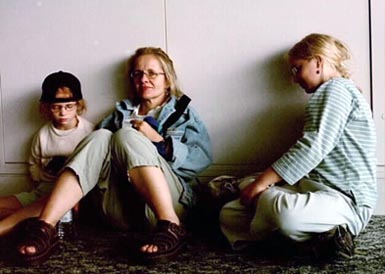
In summary, a fine trip. A study in contrasts – Spain was hot, England was cold; Spain was dry, England was wet; Spain was exotic, England was homey. We covered a lot of territory, which allowed us to bag a lot of different cities, but involved a lot of driving and packing/unpacking of suitcases. Next time, I think we’ll stay put in one or two key locations and make small trips from there.
From the girls’ point of view, the most exciting feature of the trip was having their own hotel room – a first. This meant that they could make more noise before we got annoyed enough to bang on their door and that we had no meaningful control over when they turned out the light. But it also meant that we could get away from them a bit when needed, which was exciting for us, too.
From our point of view, the architectural remains of the Moorish domination of Spain, which ended around the 15th century, were the most fascinating parts of our trip. We also enjoyed the unfamiliar feel of the cities that you experience just by strolling around and eating the local food.
The trip out went reasonably smoothly, although the connection in London Heathrow involved changing terminals, which required a degree of organization that the British seemed not able to achieve. But we made our flight and arrived around lunchtime in Barcelona airport on June 25th.
 |
 |
| Weary in Heathrow | |
We found Barcelona to be warm and friendly but expensive. We stayed at the Hotel Aragon, which was not in the Old City, where most of the tourist hotels are, but was close to Gaudi’s famous (and still unfinished) masterpiece, La Sagrada Familia. The rooms were small, the facilities limited and the daily rate distressingly high, although the staff were very friendly and helpful.
The toughest adjustment for us to make was to switch to Spanish eating habits. The first night we thought we’d dine at the hotel – we went down to the restaurant at 6 o’clock but were told by a puzzled official that – of course! – it didn’t open until 8:30.
Louise was invaluable as our official interpreter. Although she only had a little high school Spanish, she tackled all of our communications problems with great energy. On a few occasions, the results were humorous, such as the time in a restaurant in Toledo when she ordered fried eyeballs instead of fried eggs, but she always got us what we wanted in the end.
Our first day was spent on La Rambla, a central street in the Old City with a wide pedestrian space in the center. There were some odd features of our ramble down the Rambla – there were little magazine stands seemingly every 50 feet, all prominently displaying Pamela Anderson’s breasts (along with many other breasts I was not acquainted with). The girls were outraged at first by the constant pornographic assault, but soon found themselves able to ignore it. Then there were all the animal stands, selling exotic birds, bunnies, dogs, lizards and the like. These were a big hit with Toni and she had trouble understanding why we wouldn’t buy her a baby bunny on the spot. Then there were the usual mimes, acrobats and gypsies and their ilk, all of whom made the stroll interesting in their way. At one point, we ventured into the so-called Chinatown, which the guidebook made seem interesting and romantic. However, as we were preparing to walk down a rather narrow, scruffy-looking street, a Spanish passer-by called to us in broken English and explained that we would certainly be mugged and our camera stolen if we continued on our path. We thanked him profusely and retreated back to the comparative safety of Pamela’s breasts on the Rambla.
 |
| The ubiquitous Pamela |
The other main attraction in Barcelona, (other than Pamela’s breasts) is the remarkable architecture of Antoni Gaudi. We spent a couple of hours looking at La Sagrada Familia – we didn’t go in because it would have required standing in line for over an hour. It has been under construction for ever, so the new towers are a completely different color from the ones constructed in the beginning. Everything curves rather than runs straight, so they look like they grew out of a vat.
He also designed some apartment buildings that we drove past – quite unmistakable. But the most fun we had was at Parc Guell, a park Gaudi designed and including a house he actually lived in for a while. Again, lots of curves, lots of decorations using broken tile. Fascinating, and particularly delightful because it is all around you.
 |
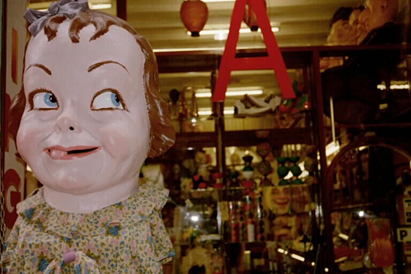 |
|
| Bread and puppet museum | ||
 |
 |
|
| Girls in courtyard | Orange trees in square | |
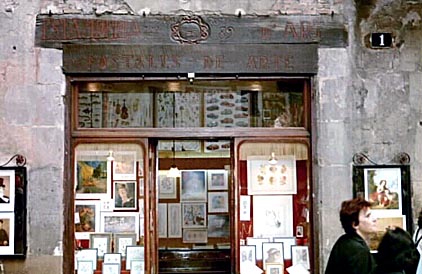 |
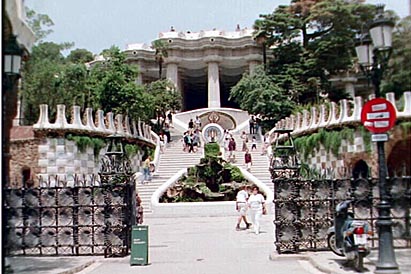 |
|
| Art shop | Entrance to Parc Guell | |
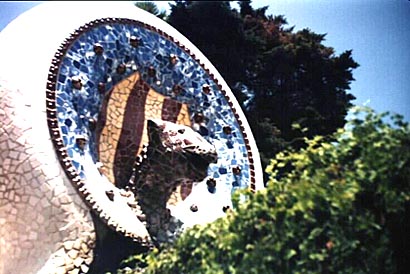 |
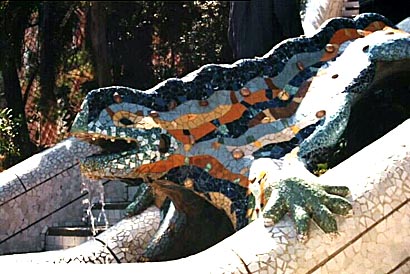 |
|
| Gaudi tile monsters in Parc Guell | ||
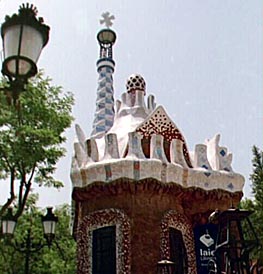 |
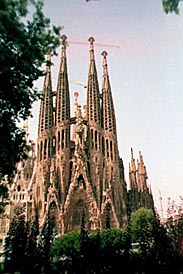 |
|
| Parc Guell | La Sagrada Familia | |
One other delight of Barcelona – we ate at a Catalonian restaurant called Els 4 Gats, said to be a hangout of artistes and the like, although we concluded that they would have to be more successful than the average artiste to be able to afford it. Food was great, though.
After 4 nights in Barcelona, we left for Zaragoza, which is the most northern city in Spain to have significant Moorish architecture. We drove a rented Renault Megane (an excellent car), stopping to check out an ancient monastery at Poblet. In Zaragoza we stayed at a splendid hotel – twice the quality of the Hotel Aragon at half the price. We strolled around the historic quarter – a huge plaza with a Moorish palace on one side and cafes on the other. We sat at a café to admire the sights and a long succession of West African youths came by to try to sell us cheap watches and jewelry and stuff. After a while, we bet on how many would ultimately come by and started keeping a tally on the paper tablecloth. Louise won the pot with the highest guess of 10, but we actually tallied 15, although a significant number of them had come around once and then forgotten us and tried a second time.
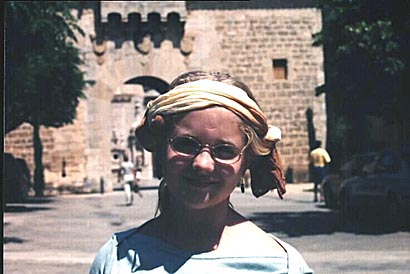 |
 |
| Maddi in Poblet | Toni in Poblet |
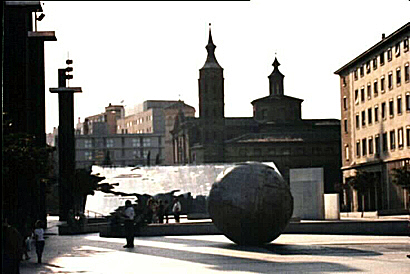 |
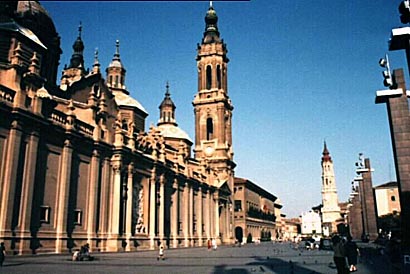 |
| Zaragoza | El Pilar in Zaragoza |
We then proceeded to Madrid. Madrid is a big city with a very energetic feel, although that wasn’t exactly what we were looking for on this vacation. It is a bit like New York – a "Come on buddy, I don’t have all day" kind of place. There are some impressive monuments – the royal palace and gardens, for example – and of course some world-class art in the Prado, but we never really felt comfortable. The traffic was bad, especially the zillions of scooters and motorcycles zipping in and out of the cars, and the side-streets got very narrow. When we arrived at the hotel, I dropped Louise off with the bags to check in while I looked for a place to park. I got swept off into a maze of teeny streets that appeared to me to leave hardly enough room for my Renault, but which by Madrid standards were three-lane highways – me in the center lane and then lanes on either side for the scooters and motorcyclists. At one point where several such little streets came together, I stopped to see where I should go and then decided to turn right. Unfortunately, at that same moment a motor scooter was zipping by at some speed on my right. Unable to stop, he smashed into my right side mirror and went down in the middle of the intersection. I jumped out of the car, imagining the worst, but the rider got up right away, muttered ‘No problemo’ and hopped back on his scooter. I was so relieved he was OK that he was long gone before I thought about who was going to pay for the mirror. I found a parking garage not far from there and resolved not to touch the car again until we were ready to leave town.
We did spend some pleasant time in Madrid’s old city drinking beer and eating tapas. We also ate at a restaurant called the Ham Museum, which the girls disapproved of because it featured dead pig, and Louise despised because of how long it took for them to settle the check. It then turned out that there were all of these other restaurants with similar names – Sir Ham, House of Ham, Ham Heaven and so on. What’s going on here?
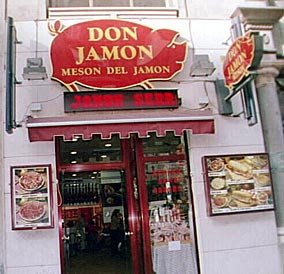 |
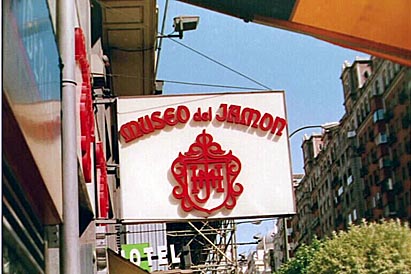 |
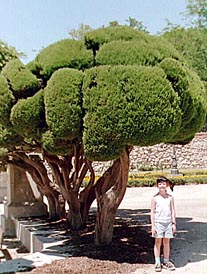 |
| Ham House | Ham Museum | Toni in Madrid |
Copyright © 2002 by Peter Lloyd-Davies. All rights reserved. Privacy Statement.